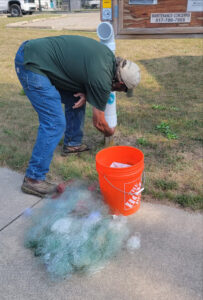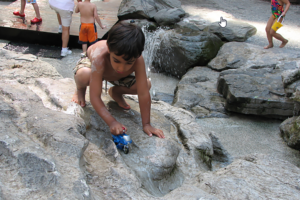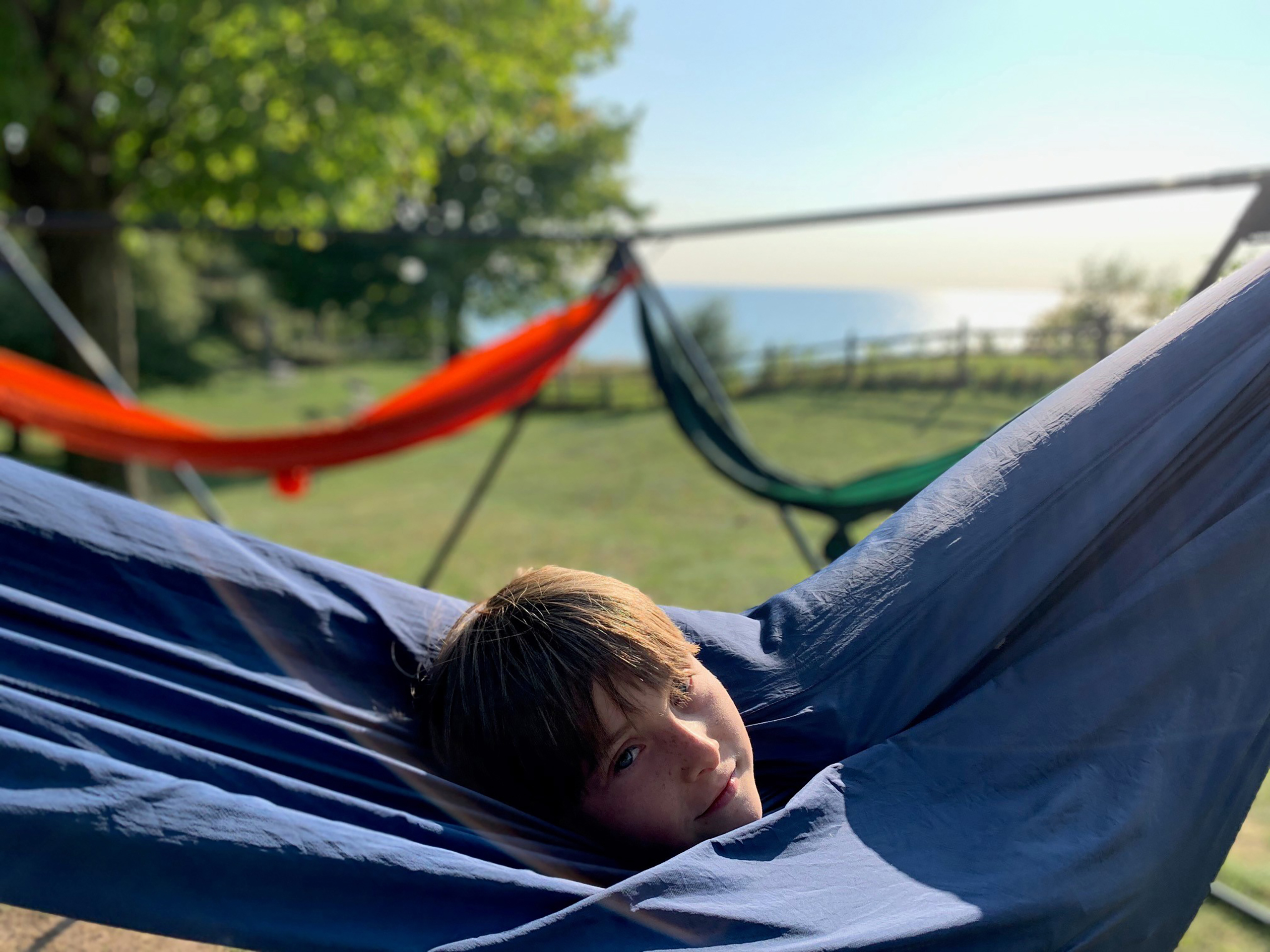Photo: Hammock camping has been available at Port Crescent State Park in Huron County for the past few years. Courtesy of Michigan Department of Natural Resources.
By HEATHER JOHNSON DUROCHER
Trails and resources writer and editor
Michigan Department of Natural Resources
Initially, Brian Dunn wasn’t so sure about designating a couple of sites at his park for hammock camping – just how popular would it be, he wondered. Would campers want to rent a hammock and sleep in it rather than pitch a tent or make use of another lodging option?
The answer, he’d learn soon enough, was a resounding “yes.”
“I’ll admit I was skeptical,” said Dunn, park supervisor at Port Crescent State Park and Port Austin Harbor in Huron County. “But surprisingly the hammocks have been getting a lot of use – I was really shocked at the number of people who really prefer hammock camping or wanted to try it. It’s quite remarkable. The sites are full, a lot.”
It doesn’t hurt that the sites have stunning Great Lake views – Port Crescent’s two hammock sites are within 30 feet of Lake Huron’s Saginaw Bay.
“It’s phenomenal, right on the water,” said Dunn, adding that up to four hammocks, which are available for rent at the park, can be set up on each site, which also features electric hook-up, a fire ring and picnic table. “We use recycled posts – MDOT [the Michigan Department of Transportation] donated these to the DNR, they’re old highway posts from I-96 – and they have multiple hooks so the hammocks can be placed at different heights.”
Dunn credits the idea of offering hammock camping at Port Crescent to Chuck Allen, a department analyst in the Michigan Department of Natural Resources Parks and Recreation Division, who believed it would be an attractive option for campers. The idea was then brought to life through a DNR Parks and Recreation fundraising program – The $2 Difference – in which campers and boaters can choose to give $2 when making their camping or boating reservation to help roll out new and enhanced amenities.
“It was right during the middle of the pandemic, these two sites had lost ground due to high water levels and erosion, and we thought it was a great time to try something new,” said Dunn of hammock camping. The park also features alternative lodging like geodesic domes. “The park now offers everything from hammock camping to traditional camping to cabins with no amenities to cabins with a full kitchen and bathroom.”
The opportunity to doze off while lying snug in a hammock beneath the stars is among numerous changes and enhancements made across the state through The $2 Difference program. Thanks to the more than 80,000 people each year who have given an additional $2 when making their reservation, the DNR has been able to introduce many new and enhanced features in recent time, from hammock-focused campsites, solar lights in vault bathrooms and fishing line recycling tubes at boating access sites, to natural play spaces, a synthetic ice rink and curling sheets, among others. Some projects are up and running while others are in progress, expected to come to life this spring and beyond.
“The two dollars that people decide to give when making a camping or harbor reservation is a small boost that adds up and goes a long way,” said Ron Olson, DNR Parks and Recreation chief. “It’s exciting to see how these donations add up and provide a way for us to implement truly innovative amenities that make visits to our parks and harbors even better.”
The start of something good
Gathering ideas and brainstorming ways of bringing them to life is at the core of the DNR Parks and Recreation Innovation Team, which formed in 2016 to collect and evaluate thoughts on improvements to parks, harbors and recreation areas that often are pitched to the division by staff, friends groups and private business owners.
“A team of staff came together from different parts of the state with different expertise to look at each idea from their perspective,” said Maia Turek, parks and recreation engagement and innovations specialist, who was instrumental in launching the innovations team. “Early ideas vetted by the innovations team include the BMX pump track at Van Riper State Park – it became the first of its kind at a Michigan state park – and floating water parks now found at Holly and Bald Mountain recreation areas. Since its start, the team has evaluated more than 120 different ideas.”
In 2019, during the Michigan state park centennial celebration, an optional $1 donation was added to the reservation process – in its first year, this program generated more than $80,000, Turek said.
“The following year, 2020, we changed it to $2 and the donations were over $150,000,” she said. “We’ve continued with The $2 Difference because we want to be sure we are spending the funds that are being donated. This fund eventually merged with the innovations team, which allows for more innovative ideas to be funded thanks to the generous contributions of our campers and boaters. Where we may have recommended a project before, but had no funding source to complete it, we can now recommend and fund projects that benefit all visitors to these special places.”

Fishing line recycling tubes are being placed at every harbor, boating access site and fishing pier through the state’s parks and recreation system. Photo courtesy of Michigan Department of Natural Resources.
Protecting aquatic wildlife – and boats
This past summer and fall, the $2 donation fund helped the DNR begin rolling out fishing line recycling tubes at every harbor, boating access site and fishing pier through the state’s parks and recreation system.
These recycling tubes are helping protect aquatic wildlife from the dangers of eating or getting tangled in fishing line and other fishing tackle, and they also help protect boat propellers. The collected fishing line is ultimately sent to Berkley Conservation to be recycled at no cost.
More than 120 volunteers and parks and recreation staff have helped build more than 1,000 tubes, said Shane Morse, park supervisor for W.J. Hayes, Cambridge Junction Historic and Watkins Lake state parks as well as Lake Hudson Recreation Area and the Jackson Field Office.
“This idea came out of the innovations team, from [Dodge 4 State Park Supervisor] Ken Huotari,” Morse said. “Michigan Cares for Tourism pledged to build all of the tubes, starting with the first 500 at the annual Pure Michigan Tourism Conference.”
Morse, who manages close to 50 boating access sites in southeast Michigan, said recycling tubes are being checked and emptied on a regular basis, with significant amounts of line being retrieved and bundled up for recycling – “none of it is going to the landfill, which is phenomenal,” he said.
Recycling fishing line in this manner is done in other states, Morse said, but “I would be shocked to know of another state that has taken it to the level that we have.”
“This was just a super good project to be able to do with other professionals from around the state,” he said of working with so many volunteers.
Knowing that the public’s $2 donations helped make this possible made it all the sweeter of an experience, he said.
“This is not a cheap effort by any means – it costs some money to put them at all the access sites and continuously check them,” he said. “The $2 donation can add up though, and this is super innovative – it’s affected our whole division. It makes a big impact, and it’s pretty cool.”
A natural way to play
Amanda Treadwell, urban area field planner in the Parks and Recreation Division, said funding from the $2 donation program is a tremendous gift that is helping bring “a unique opportunity” related to outdoor play spaces to Michigan state parks.
“We just might be the first state park system to coordinate and develop this initiative,” Treadwell said.
The initiative: partnering with the Natural Learning Institute at North Carolina State University to develop plans for natural landscape-inspired play spaces. Think natural rock formations, trails and trees at a state park, for example, which are incorporated into an outdoor environment that supports safe physical activity for children and their families.
“The play space materials would represent the eco regions that each state park is in rather than something that is standard and pulled out of a magazine,” Treadwell said. “Each one would be unique, with learning opportunities for the ecology and cultural history of the space. It would be an accessible learning space as well as a play space children and families of all ages and abilities.”
With help from The $2 Difference, the DNR is collaborating with the Natural Learning Institute to develop a resource manual, she said.

A natural play space is created by taking inspiration from the surrounding landscape. (Photo courtesy of the Natural Learning Institute at North Carolina State University)
“They’ll provide a guide to us, which will help us create these unique playscapes throughout the system,” she said, adding that the pilot location for a natural place space is Hartwick Pines State Park campground in Grayling. “It will provide maintenance and operations guidelines for these play systems and outline a process for us to work with a consultant to develop them.”
The power of $2
Starting this spring, you’ll notice a special sticker with the words “You made this happen with your reservation donation” placed on amenities funded by The $2 Difference. A few more examples of this funding at work:
- Accessible beach walkway at Pontiac Lake Recreation Area and accessible kayak launch and sunshade at Lake Hudson Recreation Area.
- Dishwashing stations at 20 state parks.
- Interpretive signage at Tahquamenon Falls and Fort Wilkins Historic state parks.
- Lighted trail equipment for winter events at Seven Lakes State Park and Ionia Recreation and Highland recreation areas.
- New harbor amenities, including laundry facilities, fire rings with seating and lawn games.
- Track chairs at North Higgins Lake, South Higgins Lake (with matching donation from Safari Club International), Warren Dunes and Wilderness state parks.
For Dunn, from Port Crescent State Park, it’s exciting to see how improvements and changes can be implemented that best fit individual parks.
“All of our parks have their own unique personalities and amenities that make sense for their visitors,” he said. “The $2 donation funding – I think it’s phenomenal. I really see it helping us do the extra things that we may not be able to otherwise swing with our budgets. It’s a nice way to add those extras that make camping and recreating more fun.”
Do you have an innovative idea for Michigan’s state parks, harbors and other recreational areas? We’d like to hear about it! Let us know your thoughts today by filling out this online survey.
Check out previous Showcasing the DNR stories at Michigan.gov/DNRStories. To subscribe to upcoming Showcasing articles, sign up for free email delivery at Michigan.gov/DNREmail.

